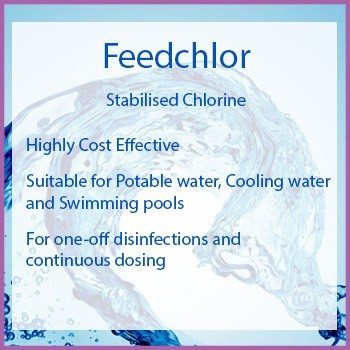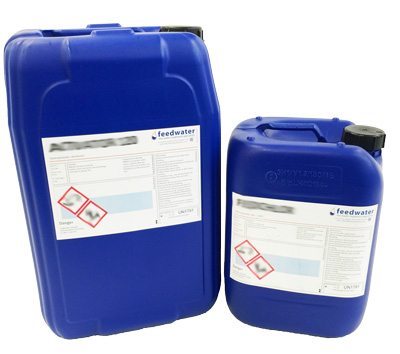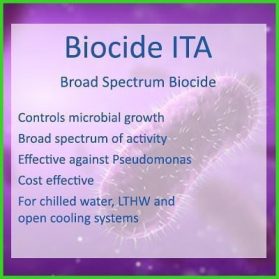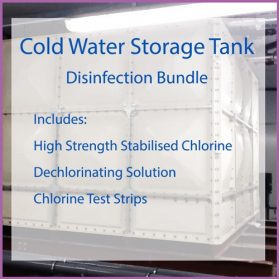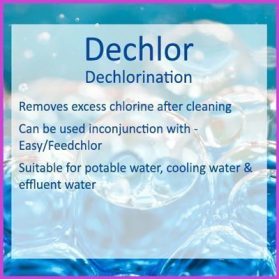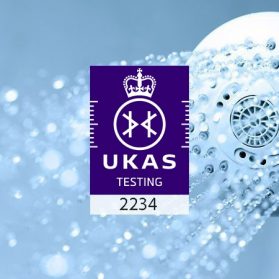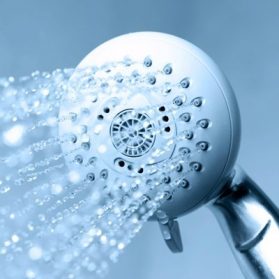Description
Feedchlor
Comes in 10 or 25kg drum (Liquid chemical)
Liquid Chlorine Disinfectant
- For drinking water, swimming pools and cooling towers
- For one-off disinfections and continuous dosing
Product Description
FEEDCHLOR is a high strength liquid chlorine solution suitable for disinfecting drinking and domestic water, swimming pools and cooling towers.
FEEDCHLOR can be used to a carry-out one-off disinfection / chlorinations or it can be dosed continuously to maintain the required chlorine residual.
FEEDCHLOR is extremely cost effective and contains a stabiliser but should be used within 6 months of purchase.
*Use biocides safely. Always read the label and product information before use.*
Dosage rate
A dosage rate of 10ml/m3 will yield approximately 1ppm (mg/l) of available chlorine.
Example
Chlorine reserve required = 50 ppm
System volume = 80 m3
Dosage required: = 50 ppm x 10 x 80 m3
= 40,000 ml
= 40 litres
Measurement of chlorine levels can be made using high or low range chlorine test kits.
Typical Applications
Continuous dosage applications
Where ongoing disinfection of drinking water is required feedchlor should be dosed to maintain 0.1 – 0.5ppm of free chlorine at the point of use.
For cooling water a limit of 0.5 – 1.0ppm of chlorine should be dosed..
Disinfection of water storage tanks and domestic down services
We now have a dedicated chemical bundle for performing tank cleans here.
- Wash down internal walls and base with a 10 % FEEDCHLOR solution. Depending on the nature of deposits present, brushes, sponges, or scouring pads maybe used to aid removal of staining and accumulation of scale.
- Vacuum clean base of tank such that all traces if sediment are removed.
- Exit tank and add sufficient FEEDCHLOR to ensure that when the tank is refilled at least 65ppm of chlorine is introduced i.e. at least 0.65 litre of FEEDCHLOR per 1000 litre of tank capacity.
- When the pre-determined contact period has elapsed it will be necessary to neutralise the free chlorine in the tank with DECHLOR.
- Add the necessary quantity of DECHLOR to the tank. In the case of large tanks it maybe necessary to mix the tank contents with a submersible pump.
(Extract from feedwater tank cleaning procedure)
Measurement of chlorine levels can be made using high or low range chlorine test kits.
Disinfection of Cooling Tower
- Initial Disinfection
Before starting work, the dosing system shall be isolated to protect probes in the system. - If necessary fill the cooling system with water and add the required quantity of Chlorine in order to maintain a free residual of 25-30 mg/l for a minimum of 2 hours. (You may also wish to add a bio-dispersant anti foam such as Biosperse 100.)
- The cooling water should be circulated using the system pumps (preferably initially with the tower fans switched off) and the chlorine level should be measured.
- Once the required chlorine residual is been established through out the system the cooling tower fans should be switched on for the remainder of the disinfection period in order to ensure that the disinfectant reaches all parts of the system that are normally wetted.
- The chlorine residual should be tested every 15 minutes and additional chlorine donor added as required to maintain the required chlorine residual for the disinfection contact time (see below).
- NB Where the system has multiple sumps the disinfectant solution should be added to each of them in order to speed the establishment of the required levels throughout the system.
Minimum Contact Time: 2 Hours
Continuous Free Chlorine Level: 25 – 30 mg/l
Initial Dosage Rate of FEEDCHLOR: 250ml/m3
The chlorine levels refer to the minimum continuous reserve that should be maintained throughout the disinfection time (i.e. after the fans have been switched back on). Chlorine will be lost continually during this time period, so the initial chlorine level should exceed the desired continuous chlorine level, as reflected in the recommended initial dosage rates.
It should be noted that the addition rates quoted in the table above are minimum dosage rates: in some cases chlorine/bromine demand may be higher than anticipated due to mode of system operation or excessive fouling.
Neutralisation using Dechlor
Once the circulation period is complete the chlorine residual should be neutralised by adding 11ml of DECHLOR per mg/l of chlorine per m3 of system content and circulated until the chlorine has been neutralised. The system should be then drained to a foul drain (sewer).
See HSG 274 Part 1 for more information.
Related Products
Dechlor – a de-chlorinating product.
Biosperse 100 – Bio-dispersant and anti-foam.
Range of Lab Micro and Chemical Analysis Kits
Test Kits
Low Range Chlorine test Kit 0-5mg/l
High Range Chlorine test Kit 0-50mg/l

